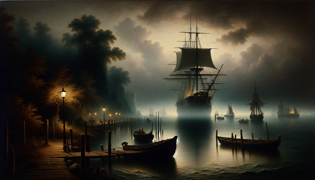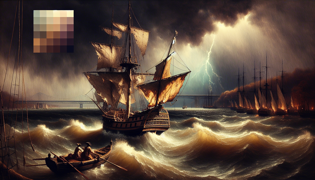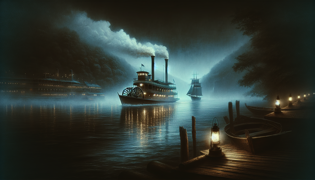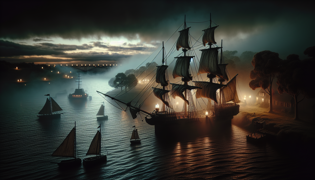The Hudson River Ghost Ship: Haunting on the Foggy Waters
Reading Time: 9 min

About Story: The Hudson River Ghost Ship: Haunting on the Foggy Waters is a Legend from united-states set in the 18th Century. This Descriptive tale explores themes of Redemption and is suitable for Adults. It offers Cultural insights. A spectral vessel emerges from the mist on fog-laden nights, carrying echoes of colonial times.
Introduction
At twilight, when the river’s broad expanse transforms into a mirror of lead, fishermen and ferry captains speak in hushed tones about the ghostly prow that cleaves through the mist. It glides like a wounded swan, sails torn as though flayed by unseen claws. Some swear they have heard its timbers groan as though the wood itself aches.
The earliest whispers date from a winter all those centuries ago, when a Dutch freighter laden with trade wafts into disaster. Cargo shifted in gale winds. A deafening crack rang out—timber splitting like a hollow bone. The crew cried for mercy against the howling wind, only to vanish in the swirling fog. To this day, the stench of pitch and seaweed surfaces whenever the river mists close in, tickling nostrils with a damp, briny tang.
Locals call it the “Knickerbocker’s tall tale,” yet they grant it power by avoiding the water’s edge on moonless nights. Lanterns flicker on the docks despite the chill in the air and the distant croak of night herons. A salty breeze whispers secrets among the reeds, carrying echoes of half-forgotten prayers.
By candlelight, elders spin yarns of phantom mariners and glimmering portholes that glow like watchful eyes. Each detail is a breadcrumb on a winding path between history and imagination. A distant horn might sigh—or is it a mournful call for atonement? The river clings to its own mysteries: a tapestry of rustling reeds, cold mud underfoot, and a lingering mustiness as if the past refuses to be buried.
Origins of the Legend
Before the American colonies thrived, Dutch merchants plied the Hudson's broad corridor like bees visiting flowers. One such freighter, the Vliegende Draeck, carried beaver pelts and rum—but, some say, also a cursed relic bound by vows of vengeance. Night turned violent. A sudden squall hurled masts into chaos. Sailcloth shredded like phantom wings. Timber snapped against the sky with thunderous finality. The crew’s cries became swallowed in the rising fog, a choking mix of brine and fear.
Survivors—if any truly returned—spoke of lanterns bobbing atop masts as though tended by shadowy hands. Others spoke of a crypt kept in the captain’s cabin, harbouring a black talisman said to have summoned a sea demon. Whether rumour or truth, the tale spread like wildfire among Knickerbockers and patroons alike. At moored barges, the scent of oiled ropes mingled with whispered dread over steaming mugs of cider.
A century passed before the first pamphlets appeared in New Amsterdam’s print shops. Under flickering lamplight, readers traced each stylised script and marvelled at woodcuts showing a vessel afloat with windows aglow and crewless decks. Parchment yellowed, curling at the edges, carried the texture of old grapevines pressed beneath leather-bound tomes. The words seemed etched by a trembling hand.
Word travelled upriver on keelboats, stopping at taverns in Albany, passing through farmsteads and ironworks, where the clang of hammer on anvil underscored the warning: do not roam the banks when the fog drifts in thick. Tales mutated, sprouting new horrors—mournful singing, billows of cold mist that swirled like wraiths, footprints on the shoreline that vanished at daybreak.
By river lore, the ship’s apparition offered redemption to those burdened by guilt. Legends told of runaway indentured servants and sailors seeking forgiveness; their lanterns guiding the way to deliverance or doom. Lantern smoke left a lingering tang, a reminder that even salvation might carry a bitter taste. The story took root in colonial hearts, a haunting song carried by the river’s steady pulse.

First Sightings on Foggy Nights
Decades after the freighter’s wreck, river pilots first reported a lights-in-the-fog phenomenon, as though guiding souls rather than vessels. Aboard the sloop Cambridge, Navigator Eliza Holt felt the air thicken, thick as stew, and tasted salt on her lips though she’d seen no sea. She described mist that clung to her hair like a damp shawl. At midnight, slender lantern lights emerged—amber flames floating at impossible heights above the waterline. The eerie glow painted ripples in ochre tones on the glassy surface.
Her crew trembled. They heard, faintly, a chorus of voices singing hymns in low registers that vibrated through the keel. The sound resonated like a cello in a cavern. Holt’s journal spoke of phantom rigging creaking as if unseen sailors climbed to peer over the rail. When they pursued the lights, the vessel retreated, slipping behind a wall of fog that swallowed the Cambridge’s bows, leaving only silence and the scent of tar and mildew.
Other accounts followed: a pilot boat near Tarrytown sensing a chill wind that smelled of rotting seaweed and brimstone. A fisherman in Ossining watched sail shadows appear against the haze and vanish in a heartbeat. Each description echoed the same tableau: lantern-lit windows, spectral boards slick with condensation and a pall of sorrow heavier than rain clouds.
Voices in sleeping taverns told of sharp, metallic clangs—like an anchor hitting iron—though no vessel lay at the moorings. Bar patrons smelled copper on their breath as though the river itself wept blood. At Peekskill, the local miller claimed he saw ghostly boots pacing the deck before disappearing through the fog, leaving wet footprints on the planks that dried in the morning sun.
Whether victims of collective hallucination or emissaries from beyond, the phantom vessel became a fixture of Hudson nights. It moved with the grace of a swan yet carried the weight of centuries, drawing in those who craved closure and pushing away the curious with icy contempt.

The Search for the Phantom Ship
By the mid-19th century, steamboats churned upriver with billowing black smoke and stern whistles that shattered dawn’s hush. A curious journalist, Thomas Reed, resolved to chase the legend for his New York Gazette feature. He chartered the Belle of Albany, a paddlewheel steamer, outfitted with telescopes, sextants, lanterns and a band of sceptical crewmen. Reed’s notebook brimmed with diagrams and scribbled interviews. He sketched the vessel’s outline like an architect drafting a monument to dread.
On a fog-choked eve, Reed’s expedition reached the narrows near Sing Sing. The air tasted like damp coal dust. Bells on the paddlewheels clanged against the mist, a hollow sound that reverberated off unseen cliffs. Suddenly, through the vapours, Reed saw what looked like royal blue sails—though they flickered one moment, gone the next. He signalled the engineer to slow the engines. The Belle drifted close enough for men to peer over the bulwarks and see ghostly laughter echoing across empty decks.
A lantern bobbed towards them, its glow so bright it seemed alive. A hand reached out from the haze—pale, veined, dissolving like smoke in the Belle’s searchlight. Reed described a scent of stale incense and old bruised wood. Men recoiled, some mumbling prayers. Others, mesmerised, wanted to leap across the gap and join the phantom crew.
They chased the spectral glow upriver for hours. Each time the Belle gained ground, the ship vanished behind a curtain of mist thicker than wool. Steam hissed from the stacks like a wounded beast. The engineer swore he heard chains dragging across the hull, though no chains hung outside the Belle.
When dawn broke, Reed stood on deck shaking, notebook soaked by condensation. The Belle’s bell clanged in mourning. The empty river lay before them, silvered by the new sun. In the months that followed, Reed’s article appeared in print, complete with hand-drawn maps and first-person testimony. It launched a wave of thrill-seekers and profiteers offering guided ghost tours. Yet none could seize the phantom ship—it remained as elusive as a dream at the edge of waking.

Legacy on the River
Over time, residents along the riverbank wove the phantom vessel into community rituals. Fisherfolk left lanterns on empty piers to guide lost souls. Schoolchildren sang rhymes about glowing windows and creaking boards—songs that clung to the air like drifting pollen. The ghost ship became as much a part of the landscape as the brownstone houses of Manhattan or the steep hills of the Palisades.
Local artisans carved miniature ships from driftwood, their hulls rough with texture, painted with phosphorescent paint that glowed at night. Innkeepers in Sleepy Hollow displayed portraits of the vessel, its sails taut even in still air. The inn’s hearth crackled with logs that smelt of pine and ash, as patrons debated whether the phantom sought forgiveness or retribution.
Modern sightings faded with bright electric lights and river traffic, yet every autumn when the river fog thickens—like spun sugar dripping from a cauldron—whispers resurface. Kayakers pause mid-paddle, reporting a chill that crawls up their spine, a faint whisper of foreign tongues and a glimmer on the horizon. Photographers claim to capture orbs of light dancing above the waves, though experts dismiss them as lens flares or ball lightning.
The Hudson’s ghost ship remains a mirror reflecting our need for closure. Historians trace its story through church records, ship logs and family letters. Pilots share tales over steaming mugs, trading dramatic flourishes: “It’ll give you goose-pimples hotter than a skillet!” they say. Each version colours the vessel anew, like a thousand stained-glass windows showing different saints.
Today, eco-conservationists invoke the legend to promote river health. They speak of the ghost ship not as a menace but as a guardian spirit, reminding us that the river’s fate mirrors our own. And on hush‑haunted nights, when fog tiptoes across the water, the phantom sails may yet billow once more, carrying with them echoes of centuries and the unquiet yearnings of wayward souls.

Conclusion
Even now, the Hudson River whispers of its phantom mariner. Though modern ferries ply the currents with engines roaring like metal beasts, the ghost ship’s legacy drifts in every ripple. Sightings are rarer, yet those who glimpse her say she moves with a timeless grace—neither good nor evil, but yearning for something lost to the ages. Each lantern in the mist is a question. Each creak in the hull, a plea.
We live alongside stories that shape how we see our world. The phantom vessel teaches that history is more than dates and monuments; it’s a living tapestry woven from memory, fear and hope. In every fog bank, we might find a reflection of our own regrets or a path to absolution. Perhaps the ghost ship embodies our collective longing: to reconcile with the past and chart a course toward redemption.
When night falls and the mist rises, pause on the river’s bank. Breathe in the chill air scented with mud and pine. Listen for the soft thud of a lantern’s glow or the sigh of broken timbers. And if, just for a moment, you think you see an ethereal sail framed against the moonlit haze, remember that legends endure not because they possess final answers, but because they keep wonder alive.

















